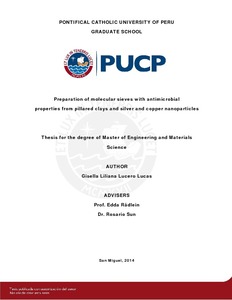| dc.contributor.advisor | Rädlein, Edda | |
| dc.contributor.advisor | Sun Kuo, María del Rosario | |
| dc.contributor.author | Lucero Lucas, Gisella Liliana | es_ES |
| dc.date.accessioned | 2017-03-09T22:05:51Z | es_ES |
| dc.date.available | 2017-03-09T22:05:51Z | es_ES |
| dc.date.created | 2014 | es_ES |
| dc.date.issued | 2017-03-09 | es_ES |
| dc.identifier.uri | http://hdl.handle.net/20.500.12404/8139 | |
| dc.description.abstract | Aluminum pillared clays (Al–PILC) modified with silver and copper nanoparticles were
prepared in order to get a material with antimicrobial properties against Escherichia coli (E.
coli) and Staphylococcus aureus (S. aureus). Al-PILC were characterized by X - ray
diffraction (XRD), Scanning electron microscopy (SEM) with energy – dispersive X - ray
spectroscopy (EDX), the Boehm titration and the nitrogen sorption method. According to
these techniques, the pillaring process increased the interlayer distance in 8.7 Å and it
corresponds approximately to the size of the Keggin´s ion. The surface area of the natural
clay grew from 56 m2/g to 195 m²/g for the Al-PILC after its calcination because new
micropores arise.
Silver and copper nanoparticles were prepared by a chemical reduction method using D –
glucose and ascorbic acid as reductor agents. Silver and copper nanoparticles were analyzed
by UV – Visible spectroscopy and SEM – EDX. In addition, the silver concentration in a
suspension was determined by atomic absorption spectroscopy. Nanoparticles were spherical
and their particle size was between 15 and 33 nm and they were immersed in a starch matrix.
Synthesis conditions (frequency and temperature) had an influence on the particle size which
increased with higher frequency (80 kHz) and temperature (59°C). Copper nanoparticles
were prepared using different volume of ascorbic acid; 1.6 ml produced smaller particles (20
– 86 nm); however, this range of particle size was not reproducible. For that reason, in the
microbiological experiments were used commercial copper nanoparticles with a size
between 27 nm and 34 nm.
Silver al copper nanoparticles were incorporated to Al–PILC by impregnation and the
modified clays were characterized by SEM –EDX. From the microbiological experiments,
the silver and copper suspensions reduce the number of S. aureus and E. coli alive cells in
comparison to the number of alive cells in the sample without modified clay and
nanoparticles. | es_ES |
| dc.description.uri | Tesis | es_ES |
| dc.language.iso | spa | es_ES |
| dc.publisher | Pontificia Universidad Católica del Perú | es_ES |
| dc.rights | info:eu-repo/semantics/closedAccess | es_ES |
| dc.subject | Ingeniería química | es_ES |
| dc.subject | Nanotecnología | es_ES |
| dc.subject | Microbiología--Experimentos | es_ES |
| dc.subject | Rayos X | es_ES |
| dc.title | Preparation of molecular sieves with antimicrobial properties from pillared clays and silver and copper nanoparticles | es_ES |
| dc.type | info:eu-repo/semantics/masterThesis | es_ES |
| thesis.degree.name | Maestro en Ingeniería Mecánica | es_ES |
| thesis.degree.level | Maestría | es_ES |
| thesis.degree.grantor | Pontificia Universidad Católica del Perú. Escuela de Posgrado | es_ES |
| thesis.degree.discipline | Ingeniería Mecánica | es_ES |
| renati.discipline | 713347 | es_ES |
| renati.level | https://purl.org/pe-repo/renati/level#maestro | es_ES |
| renati.type | http://purl.org/pe-repo/renati/type#tesis | es_ES |
| dc.publisher.country | PE | es_ES |
| dc.subject.ocde | https://purl.org/pe-repo/ocde/ford#2.03.01 | es_ES |






